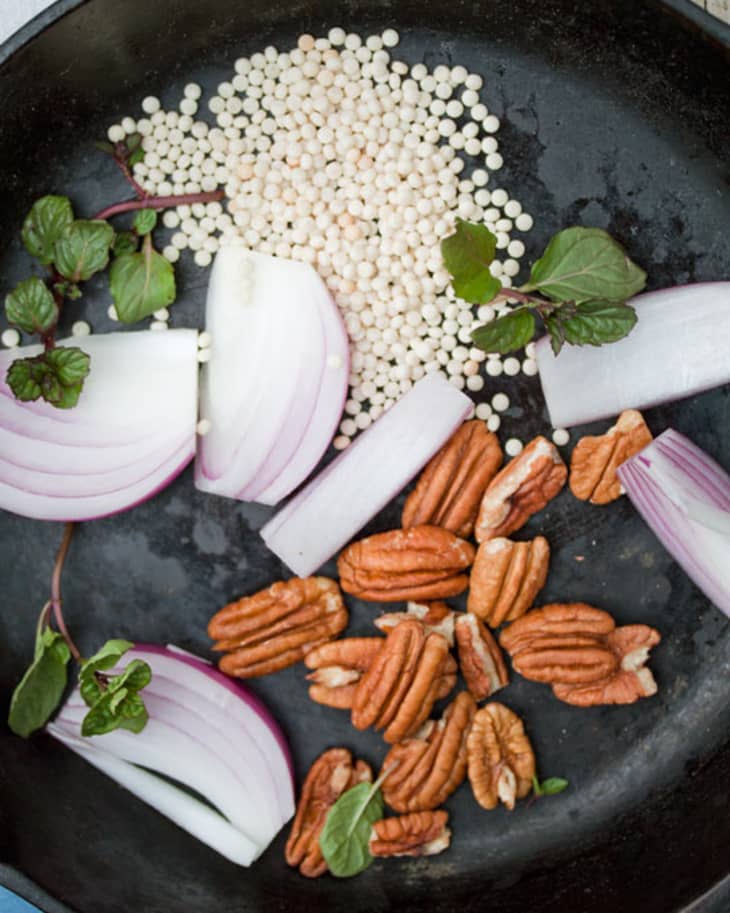15 Essential Ingredients for Vegetarian & Vegan Pantries
Alongside the usual savory and sweet items that every pantry needs, there are a few ingredients that are particularly useful for vegetarians and vegans, as well as those wanting to eat more meatless meals. All of these items are ideal for adding protein, texture, and flavor to what you’re cooking.
Each household’s pantry will vary according to personal taste, ethnic background, and food allergies, but these 15 items are a great way to get started.
A couple of these items do go beyond the pantry, but they’re great meatless staples to have on hand.
15 Essentials for your Vegetarian (or Vegan) Pantry
1. Beans
Though I like to keep a variety of dried or canned beans, I always make sure my pantry has at least two: lentils and chickpeas. Lentils cook quickly and are great additions to soups, pilafs, and salads. I like to throw chickpeas into pasta dishes and vegetable braises and stews. Pinto, black, kidney, and cannellini beans are also good to have on hand.
→ Soak dry beans faster! How To Quick-Soak Dried Beans in Just One Hour
2. Grains
Using a variety of grains lends nutrition, texture, flavor, and makes vegetarian and vegan meals more interesting. I like to keep my pantry stocked with brown rice, white rice, quinoa, spelt, farro, millet, and bulgur.
3. Tempeh
Once you know how to prepare tempeh, it can be one of the best staple sources of protein. It can be refrigerated for a week or two (check the date on the package) and will keep up to several months in the freezer.
→ Make your own! How To Make Tempeh
4. Tofu
Like tempeh, tofu is not strictly a pantry item, but it’s an essential for vegetarian kitchens. I like to keep blocks of refrigerated extra firm tofu for baking and frying, vacuum-packed silken tofu to blend into dressings and puddings, and dried tofu for soups and stir-fries.
→ Tofu inspiration: 15 Delicious Ways to Eat Tofu All Day Long
5. Nuts
I always have almonds and cashews and try to keep pistachios and pine nuts around, too. Whole or chopped nuts can be used in salads and grain dishes. Ground nuts can add body to lasagna. And there’s always pesto. Extend the life and freshness of nuts by keeping them in the freezer.
6. Dried fruits
Raisins, dried apricots, and dates are not only great for snacking, but they can add unexpected and delicious flavor to grain dishes, vegetable braises, and sautéed greens.
7. Vegetable stock
I prefer to make stock from scratch and keep it in the freezer. But if you don’t have the time or inclination, there are plenty of good store-bought options.
→ Make your own! How To Make Vegetable Stock
8. Nutritional yeast
Nutritional yeast is somewhat of a new pantry item for me, though I’m very quickly coming to love it. It can be used in sauces or as a coating for tofu, and sprinkled on potatoes and popcorn.
9. Miso
I like to keep both light and dark miso paste in the refrigerator for different degrees of savoriness, but if I had to choose just one, it would be the mellow white variety. Miso makes excellent soup as well as dressings for salad, vegetables, and tofu.
→ Know the difference! What’s the Difference? White, Yellow, and Red Miso
10. Tahini
Tahini, or sesame paste, often works in conjunction with miso in my kitchen. A quick tahini-miso sauce (try adding lemon juice and garlic, too) can be poured over steamed vegetables, tofu, or tempeh for simple weeknight dinners.
→ More Ways to Use Tahini: 5 Smart Ways to Use Tahini
11. Dried sea vegetables
I like to keep several kinds of seaweed, from sheets of nori that can be wrapped around rice and vegetables, to kelp and kombu that add flavor to broth, to hijiki that can be reconstituted and used in salads and vegetable dishes.
12. Coconut oil
From making rich curries and roasting vegetables, to searing tofu and even baking, coconut oil is super versatile.
14. Maple syrup
Maple syrup is my favorite natural sweetener. It’s perfect for baking, making dressing and glazes, and of course, you can never use too much of it on pancakes.
→ What You Might Not Know: 5 Surprising Facts About Maple Syrup
15. Ground flax seeds
Flax seeds are super nutritious and loaded with fiber and Omega-3 fatty acids. I love them stirred in my oats, mixed into smoothies, and baked into breads and muffins. And, combined with a little bit of water, ground flax also works as an egg substitute.
What else would you add to this list?
Updated from a post originally published January 2009.
